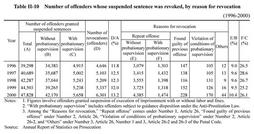| Previous Next Index Image Index Year Selection | |
|
|
5. Suspended sentence (1)Suspension of execution of sentence
The suspended execution rate for defendants sentenced to imprisonment with labor, which remained around 50% until 1993, has been around 60% since 1994. The suspended execution rate for those sentenced to imprisonment without labor has been remaining around the level of 90% every year, higher than that for imprisonment with labor. When giving the first suspended sentence (Clause 1, Article 25 of the Penal Code), at their discretion, courts decide whether offenders should be placed under probationary supervision at the same time. In the case of giving repeat suspended sentence to offenders who have committed a further offense (Clause 2, Article 25), however, probationary supervision shall be mandatory. In 2000, 47, 376 offenders (99.1% of all offenders given final suspended sentences) were given first suspended sentence, of which 5,206 (10.9%) were placed under probationary supervision. 452 offenders (0.9%) were given repeat suspended sentence (Source:Annual Report of Statistics on Prosecution). (2)Revocation of suspended sentence Table II-10 shows the number of offenders whose suspended sentence was revoked over the last five years, by reason for revocation. The number of offenders whose suspended sentence was revoked increased by 964 (18.1%) from the previous year to 6,301 in 2000, and an overwhelming majority of them, 93.0%, were subject to revocation on the reason that they committed a repeat offense and were sentenced to imprisonment without labor or graver punishment. The number of offenders who were given suspended sentence in a given year and the number of offenders whose suspended sentences were revoked in that year target different groups offenders, and therefore the rate of the latter number to the former cannot strictly be called the revoked suspension rate. However, calculated for the purpose of ascertaining general trends, the revoked suspension rate was 13.2% and the revoked suspension rate due to repeat offenses by those who received suspended sentence with probationary supervision was 26.1%. By type of offense (limited to those for which both the total number of offenders given suspended sentence and the number of offenders given suspended sentence with probationary supervision were at least 100), the revoked suspension rate was high for Stimulant Drug Control Law violations (23.4%) and larceny (22.0%) while the revoked suspension rate due to repeat offense committed by those who received suspended sentence with probationary supervision was high for larceny (34.3%) and Stimulant Drug Control Law violations (30.0%). Table II-10 Number of offenders whose suspended sentence was revoked, by reason for revocation(1996-2000) |
